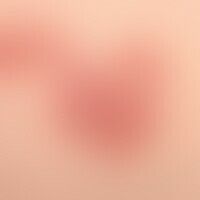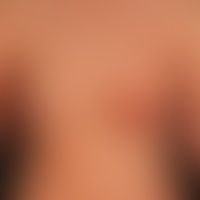Image diagnoses for "Torso", "Plaque (raised surface > 1cm)"
269 results with 958 images
Results forTorsoPlaque (raised surface > 1cm)
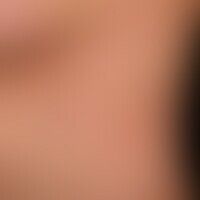
Atrophodermia idiopathica et progressiva L90.3
Atrophodermia idiopathica et progressiva: slowly progressive, large, light-grey, non-symptomatic patches (plaques)

Granuloma anulare disseminatum L92.0
Granuloma anulare disseminatum. general view: Non-painful, non-itching, disseminated, large plaques on the abdomen of a 43-year-old female patient. no diabetes mellitus.

Lichen sclerosus (overview) L90.4
Lichen sclerosus et atrophicus generalized. large-area infestation with parchment-like skin alteration. red wheals in places, indicating that the process is "still active".
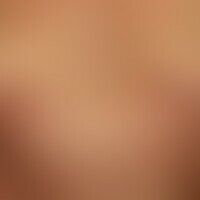
Mycosis fungoides plaque stage C84.0
Mycosis fungoides (plaque stage): 72-year-old male (sucking plaque stage of Mycosis fungoides); multiple, disseminated, 5.0-10.0 cm large, occasionally slightly itchy, only slightly consistency increased, slightly scaly red, poikilodermatic plaques are found.

Kaposi's sarcoma (overview) C46.-
Kaposi's sarcoma:Generalization of angiosarcoma. Disseminated spots and flat plaques. Characteristic is the arrangement in the tension lines of the skin, whereby a striped arrangement is recognizable in places.

Erythrokeratodermia figurata variabilis Q82.8
Erythrokeratodermia figurata variabilis. very irregularly distributed, bizarrely configured, polycyclic, scaly plaques with alternating clinical expressivity and acuteness as well as very characteristic peripheral scaly ruffs (buttocks) in a 6-year-old boy. few symptomatic skin lesions existing since 2 years.

Keratosis seborrhoeic (overview) L82
keratosis seborrhoeic: multiple flat wart-like skin growths that have persisted for years. arrows mark smaller, flat, light brown seborrhoeic keratoses. encircled: verucosal plaques or nodules that have existed for a long time (several years). patient complains of itching at times.

Erythema multiforme, minus-type L51.0
Erythema multiforme: sudden, exanthematic spread of red spots, plaques and blisters.
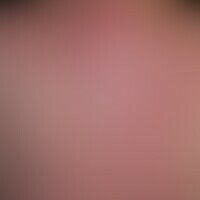
Schnitzler syndrome L53.86
Schnitzler syndrome: recurrent fever attacks; moderately itchy, urticarial exanthema; systemic signs such as fatigue and tiredness; IgM paraproteinemia.
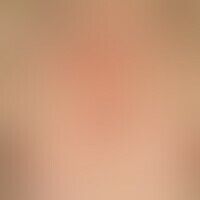
Psoriasis seborrhoic type L40.8
Psoriasis seborrhoeic type: Chronic recurrent, sharply defined red spots and plaques, which are localized in the chest area of a 70-year-old man and run along the anterior sweat channel.

Candidosis intertriginous B37.2
Differential diagnosis "candidiasis intertriginous" : present psoriasis intertriginosa: infection-related acute relapsing activity of a long term known psoriasis vulgaris.

Transitory acantholytic dermatosis L11.1
transient acantholytic dermatosis. detail enlargement from previous overview. initial papules, about 1-2 mm in size, deep red with slightly eroded, occasionally scaly surface, characterize the picture. in addition, older plaques (top right) resulting from confluent papules with slight marginal scaling are visible. the nikolski phenomenon is negative.

Sarcoidosis of the skin D86.3
Anular sarcoidosis: anular or circulatory chronic sarcoidosis of the skin. existing for several years. onset with small symptomless papules with continuous appositional growth and central healing. no detectable systemic involvement .
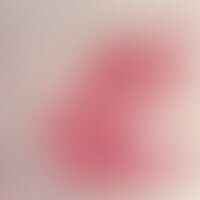
Paget's disease of the nipple C50.0
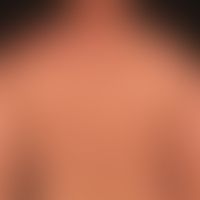
Folliculotropic mycosis fungoides C84.0
Mycosis fungoides, folliculotropic. 3-year-old clinical picture with strongly itchy, moderately sharply defined, follicular red plaques.

Sézary syndrome C84.1
Sézary syndrome: universal redness with small lamellar scaling, massive itching, pain at times.

Mycosis fungoides C84.0
Mycosis fungoides: 52-year-old man (tumour stage of mycosis fungoides). 52-year-old man (tumour stage of mycosis fungoides). Multiple, disseminated, 1.0-5.0 cm large, itchy and slightly painful, clearly consistency increased, red, rough, partially scaly plaques and nodules appear in universally reddened skin. Clinically and histologically detectable LK infestation.

Transitory acantholytic dermatosis L11.1
Transitory acantholytic dermatosis (M.Grover): detailed picture
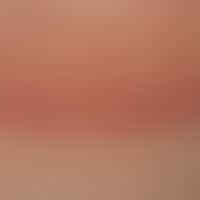
Tinea corporis B35.4
Tinea corporis in immunodeficiency. Marginal area of the lesion with broad, raised, scaly margins. Centrally located healing pattern with scaly plaques and papules between normalized skin areas.

